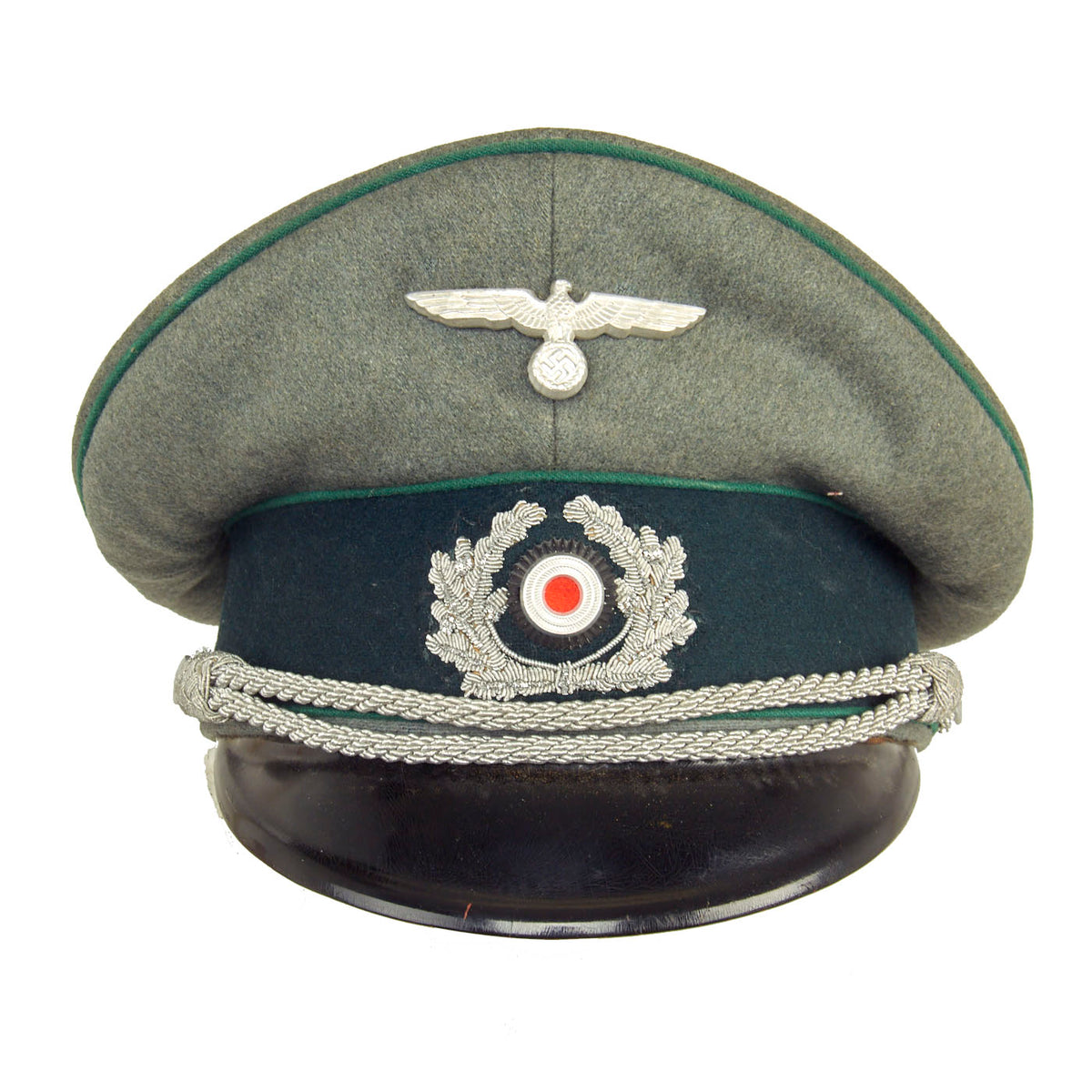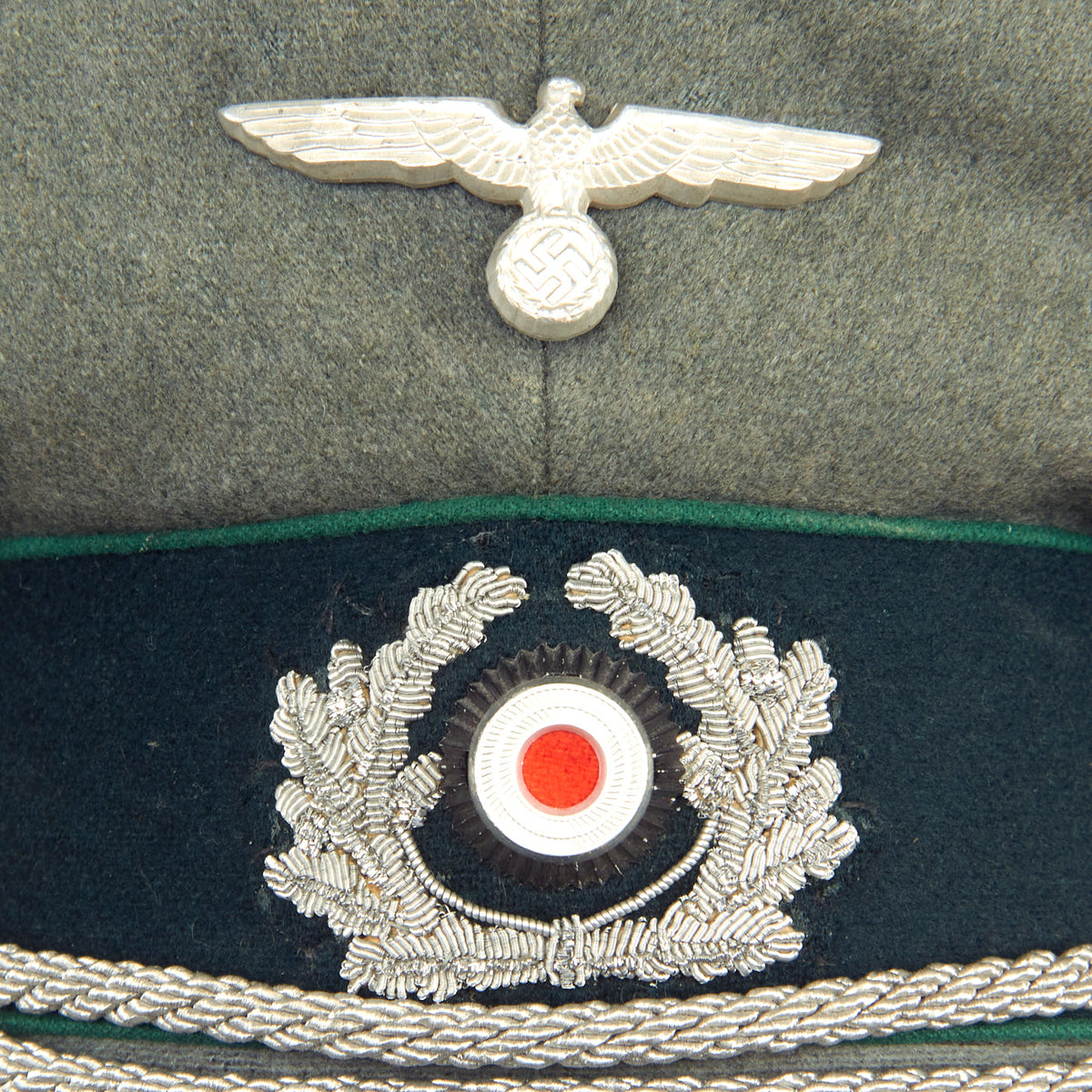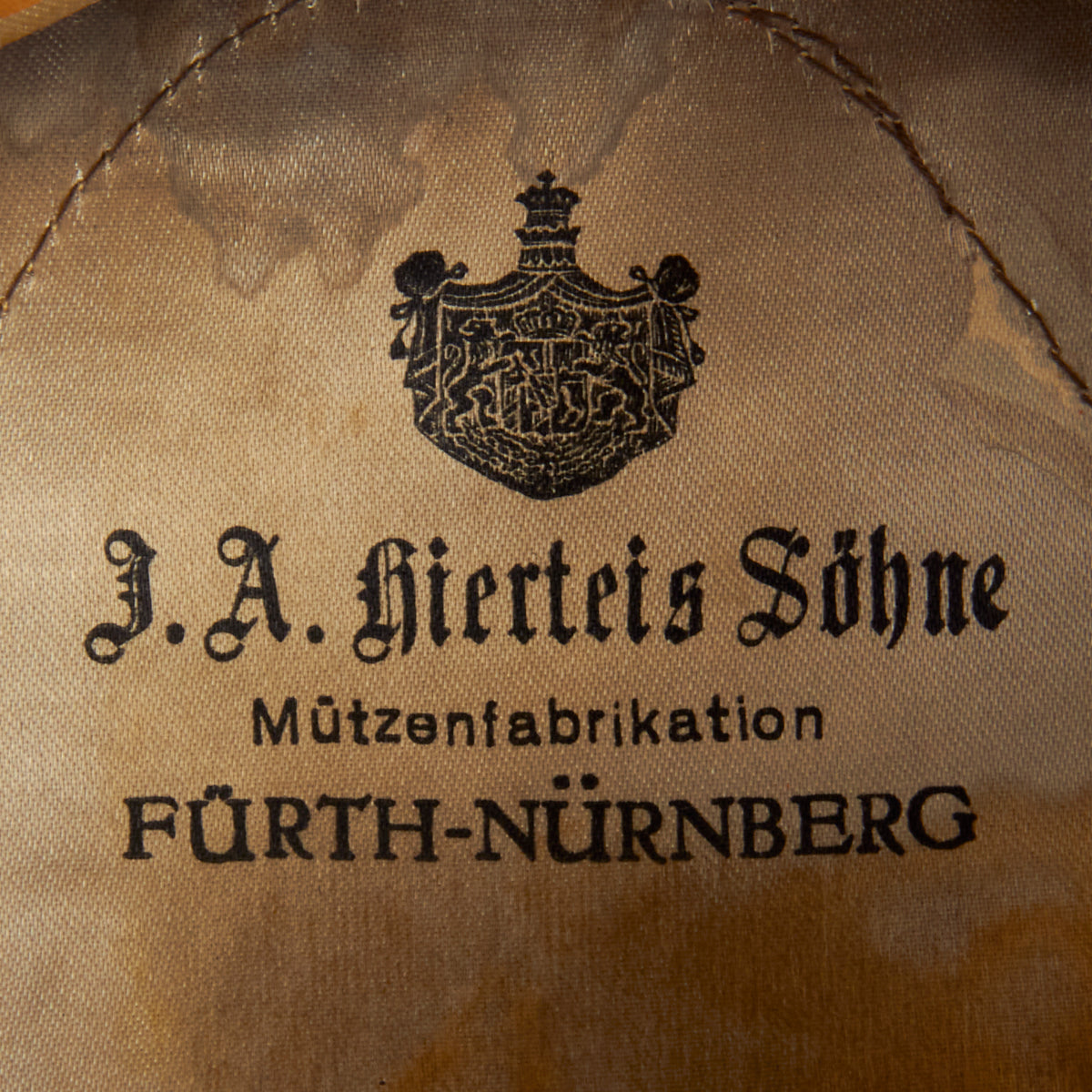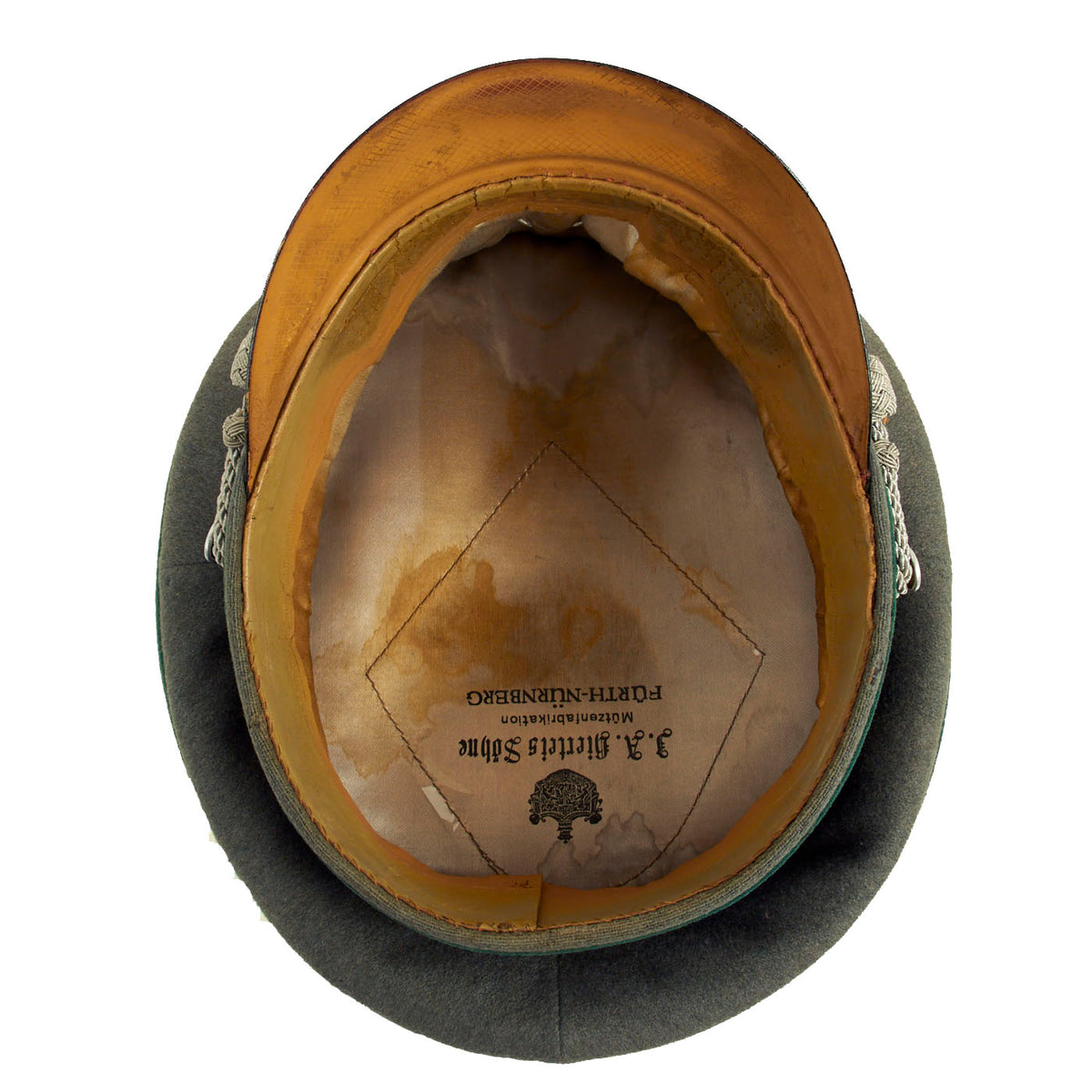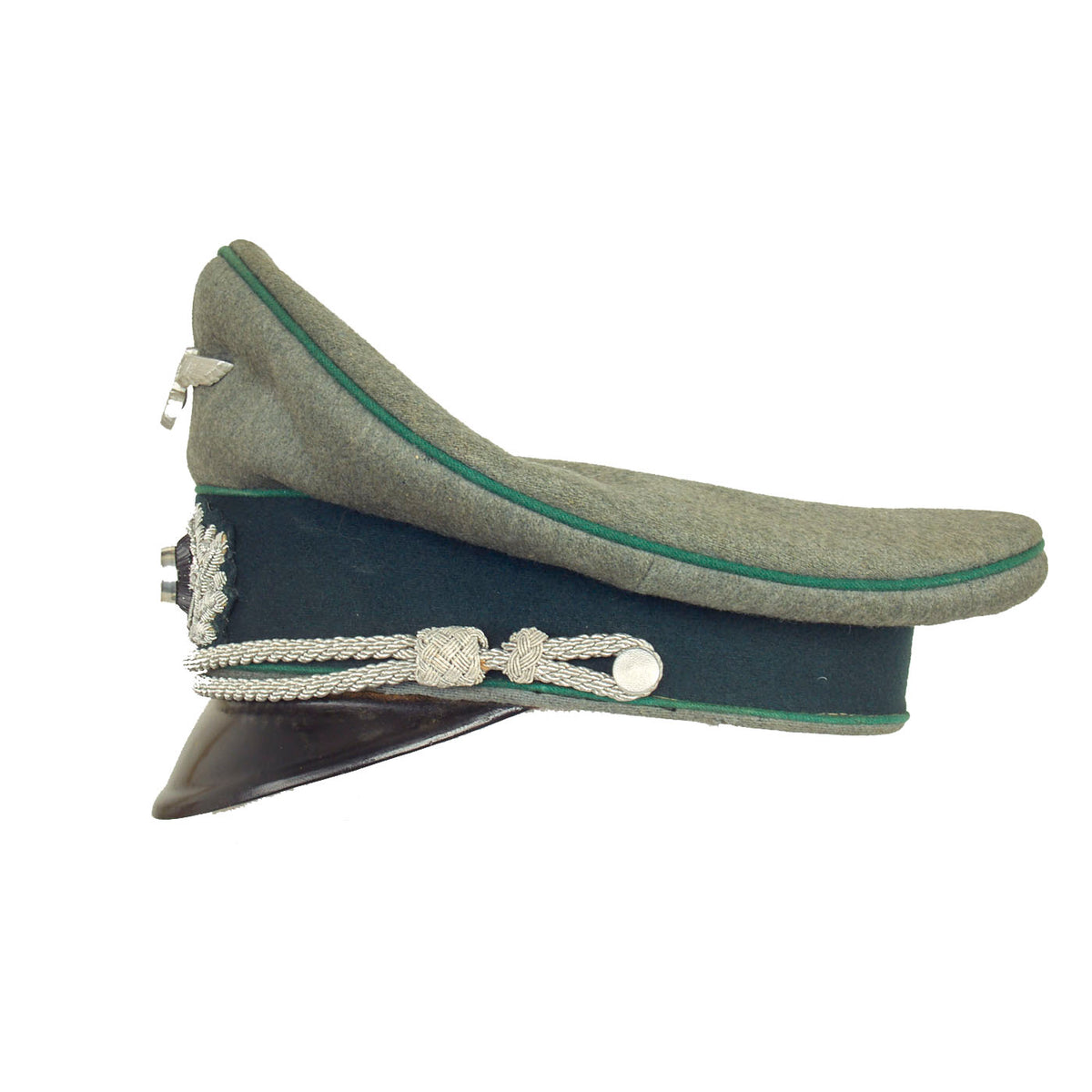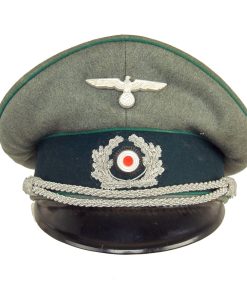Original German WWII Army Heer Jäger Officer Schirmmütze Visor Cap by J.A. Hierteis Söhne Original Items
$ 995,00 $ 248,75
Original Item: Only One Available. This cap is a fantasatic example of a German WWII Wehrmacht Heer Jäger Officer Schirmmütze visor cap, made by the very desirable J.A. Hierteis Söhne company. It features the typical green wool gabardine construction with a forest green band and a traditional high forward crown. The crown stiffener has been removed, giving it a lovely “saddle form” crushed shape. It also has matching hellgrün (light green) piping along the top edge and flanking either side of the band, the Corps Color (Waffenfarbe) for Gebirgsjäger (mountain troops), Skijäger (ski troops), and Jäger (light infantry troops). It has the correct silver bullion chin strap, indicating that it is for an officer.
It is decorated with a very nice stamped aluminum eagle insignia on the peak and and an open silver bullion embroidered wreath surrounding a metal tri-color cockade on the band. The red felt insert on the cockade is still present and vibrant. The chin strap is attached with the standard silvered buttons on either side of the cap. The vulcanfibre visor has a smooth black leather-look upper, exhibiting light wear along the edge and is beige on the underside. The sweatband looks to be beige pressed paper, which has become discolored due to use and age. Size is approximately US 7 (56cm).
The cap is lined with lovely soft light gray rayon, though the entire celluloid sweatshield is almost completely gone, with the stitching still retained. However the complete maker logo is still visible under a what looks to be a German Empire era logo:
J.A. Hierteis Söhne
Mützenfabrikation
FÜRTH-NÜRNBERG
Condition of the cap is very good, with the colors retained very well. There is no major moth damage we can see, and this example would really be hard to improve upon.
A fantastic example of the classic hat worn by German Jäger Officers in WWII. Very impressive and ready to display!
German Jäger Units –
Jäger (hunter) is a German military term referring to specific light infantry units. In German-speaking states during the early modern era, the term Jäger came to denote light infantrymen whose civilian occupations (mostly hunters and foresters) made them well-suited to patrolling and skirmishing, on an individual and independent basis, rather than as part of a large-scale military unit or traditional line infantry. As a consequence, Jäger was used to describe skirmishers, scouts, sharpshooters and runners.
The German Empire had various different Jäger units, which were disbanded at the conclusion of WWI. The Reichswehr of Weimar Germany did keep their traditions somewhat intact, and during the NSDAP led rearmament preceding WWII, various different Jäger units were reformed, the most famous of which were the Heer Gebirgsjäger Mountain Troopers and Luftwaffe Fallschirmjäger paratroopers. Later in the war, Skijäger Ski Troopers and Jäger Infantry units were raised, as well as some smaller units with more specific purposes, such as “Tank Hunters”.
The German Schirmmütze Visor Cap:
The visor cap (Schirmmütze) was an important part of the headgear worn by German uniformed military, civil, paramilitary and political organizations during the Third Reich. This was the standard cloth headgear worn as a part of the service uniform. Visor caps were worn outdoors as well as indoors, and were often required to be worn by all personnel on duty. Visor caps were made in versions specific to each organization and were often further differentiated through the use of insignia, colored piping, or style of chin cord, to indicate rank, role or branch. The insignia used on these caps ranged from simple stamped metal emblems, to elaborate hand embroidery. Visor caps were issued to enlisted soldiers and NCOs in the military and in some other organizations. Officers had to purchase their own hats, and lower ranks could choose to purchase caps that were of a higher quality than the rather basic, issue examples. The private purchase caps were generally made in very high quality, with fine materials. A wide variety of fabrics were used, from Trikot and doeskin, to heavy wool, or even lightweight white fabric for summer wear. In the military, issue of these caps was generally suspended shortly after the outbreak of the war, but they continued to be worn by some troops until the end of the war.
Fast Shipping with Professional Packaging
Thanks to our longstanding association with UPS FedEx DHL, and other major international carriers, we are able to provide a range of shipping options. Our warehouse staff is expertly trained and will wrap your products according to our exact and precise specifications. Prior to shipping, your goods will be thoroughly examined and securely secured. We ship to thousands clients each day across multiple countries. This shows how we're dedicated to be the largest retailer on the internet. Warehouses and distribution centres can be located throughout Europe as well as the USA.
Note: Orders with more than one item will be assigned a processing date depending on the item.
Before shipping before shipping, we'll conduct a thorough inspection of the items you have ordered. Today, the majority of orders will be delivered within 48 hours. The delivery time will be between 3-7 days.
Returns
The stock is dynamic and we cannot completely manage it because multiple stakeholders are involved, including our factory and warehouse. So the actual stock may alter at any time. It's possible that you may not receive your order once the order has been made.
Our policy is valid for a period of 30 days. If you don't receive the product within 30 days, we are not able to issue a refund or an exchange.
You can only return an item if it is unused and in the same state as the day you received it. You must have the item in its original packaging.
Related products
Uncategorized
Uncategorized
Armored Burgonet Helmet & Polearm from Scottish Castle Leith Hall Circa 1700 Original Items
Uncategorized
Uncategorized
Band of Brothers ORIGINAL GERMAN WWII Le. F.H. 18 10.5cm ARTILLERY PIECE Original Items
Uncategorized
Uncategorized
Uncategorized
Australian WWII Owen MK1 Machine Carbine SMG Custom Fabricated Replica with Sling Original Items
Uncategorized
Uncategorized
Uncategorized
Uncategorized
Uncategorized
Uncategorized
Uncategorized
Uncategorized
Uncategorized
Uncategorized
Uncategorized
Uncategorized
